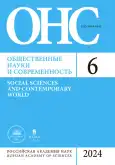Депопуляция стран Балтии в условиях европейской интеграции
- Авторы: Кондратьева Н.Б.1
-
Учреждения:
- Институт Европы РАН
- Выпуск: № 6 (2024)
- Страницы: 68-82
- Раздел: Проблемы миграции
- URL: https://gynecology.orscience.ru/0869-0499/article/view/681325
- DOI: https://doi.org/10.31857/S0869049924060055
- EDN: https://elibrary.ru/JBLIYW
- ID: 681325
Цитировать
Полный текст
Аннотация
В странах зарубежной Прибалтики, ставших донорами трудовых ресурсов для благополучных стран Европейского союза, происходит депопуляция. Показано существенное и стабильное сокращение населения Латвии, Литвы и Эстонии с конца 1980-х гг. и до сегодняшних дней в сравнении с другими догоняющими странами ЕС. Невнимание к проблеме депопуляции догоняющих стран следует трактовать как крупный просчет наднационального уровня власти ЕС и испытание для основополагающего принципа европейской интеграции – свободы передвижения людей. В числе причин устойчивости отставания в развитии стран периферии от стран ядра ЕС предлагается рассматривать существенное снижение благосостояния, вызванное депопуляцией. Отсюда вытекают причины неспособности ЕС справиться с задачей сгладить территориальные диспропорции; стимулирование экономического роста догоняющих стран требует более значительного притока капиталов и трансфертов из бюджета ЕС, так как часть их направляют на компенсацию потерь от оттока населения. Особое внимание уделено дискуссии на национальном и наднациональном уровнях о перспективах ЕС. В ней наметился поворот к постановке задач демографического перехода, который имеет основание стать еще одной движущей силой трансформации ЕС наряду с зеленым и цифровым переходом.
Полный текст
Об авторах
Наталия Борисовна Кондратьева
Институт Европы РАН
Автор, ответственный за переписку.
Email: nkondratieva@inbox.ru
ORCID iD: 0000-0002-8801-3126
кандидат экономических наук, ученый секретарь, ведущий научный сотрудник Отдела исследований европейской интеграции, руководитель Центра экономической интеграции
Россия, МоскваСписок литературы
- Оленченко В.А. (2021) Страны Прибалтики в Евросоюзе: основные характеристики членства и антироссийская ориентация // Общественные науки и современность. № 4. С. 64–76. https://doi.org/10.31857/ S086904990016456-3 Olenchenko V. (2021) Baltic States in the European Union: Main Characteristics of Membership and Anti-Russian Orientation. Obshchestvennye nauki i sovremennost’, no. 4, pp. 64–76. https://doi.org/10.31857/ S086904990016456-3 (In Russ.)
- Пророкович Д. (2023) Депопуляция Балкан: как опустошается периферия ЕС // Современная Европа. № 6. С. 71‒80. https://doi.org/10.31857/S0201708323060074 Proroković D. (2023) Depopulation of the Balkans: how the EU Periphery is Hollowing Out. Sovremennaya Evropa, no 6, pp. 71‒80. https://doi.org/10.31857/S0201708323060074 (In Russ.)
- Berzins A., Zvidrins P. (2011) Depopulation in the Baltic States. Lithuanian Journal of Statistics, vol. 50, no 1, pp. 39–48.
- Coleman D., Rowthorn R. (2011) Who’s afraid of population decline? A critical examination of its consequences. Population and Development Review, no 37, pp. 217–248. https://doi.org/10.1111/j.1728-4457.2011.00385.x
- Cruz M., Ahmed S.A. (2018) On the impact of demographic change on economic growth and poverty. World Development, vol. 105, pp. 95–106. https://doi.org/10.1016/j.worlddev.2017.12.018
- Dijk van J., Brunow S., Dall Schmidt T. (2022). The long-term consequences of brain drain related to depopulation on social and territorial cohesion with a focus on the North of the Netherlands and a short comparison with Germany and Denmark: Research Report Department of Economic Geography. RUG Faculty of Spatial Sciences. 133 p. https://pure.rug.nl/ws/portalfiles/portal/250905234/Braindrain_paper_DG_REGIO_Jouke_van_Dijk_October_2022.pdf
- Fihel A., Okólski M. (2019) Population decline in the post-communist countries of the European Union. Population & Societies, no 567(6), 1–4. https://shs.cairn.info/journal-population-and-societies-2019-6-page-1?lang=en
- Gebauer C. Sommer R. (2024) Beyond Vicarious Storytelling: How Level Telling Fields Could Help Create a Fair Narrative on Migration [version 2; peer review: 2 approved] Open Research Europe, 3:10. https://doi.org/10.12688/openreseurope.15434.2
- González-Leonardo M., Newsham N., Rowe F. (2023) Understanding population decline trajectories in Spain using sequence analysis. Geographical Analysis, no 55, pp. 495–516. https://doi.org/10.1111/gean.12357
- Kyriazi A., Visconti F. (2023) Free Movement and Welfare in the European Union: The Social Consequences of the Right to Exit. International Migration Review, 0(0). https://doi.org/10.1177/01979183231185096
- Lianos T.P., Pseiridis A., Tsounis N. (2023) Declining population and GDP growth. Humanit Soc Sci Commun 10, 725 https://doi.org/10.1057/s41599-023-02223-7
- Newsham N., Rowe F. (2023) Understanding trajectories of population decline across rural and urban Europe: A sequence analysis. Population, Space and Place, vol. 29, issue 3, e2630. https://doi.org/10.1002/psp.2630
- Schmidt S. K., Blauberger M., Martinsen D. S. (2018). Free movement and equal treatment in an unequal union. Journal of European Public Policy, no. 25 (10), pp. 1391–1402. https://doi.org/10.1080/13501763.2018.1488887
- Tagliacozzo S., Guadagno L., Ayeb-Karlsson S. (2022) How do population movements fit within the framework of systemic risk? Progress in disaster science, vol. 16, 100256. https://doi.org/10.1016/j.pdisas.2022.100256
Дополнительные файлы











